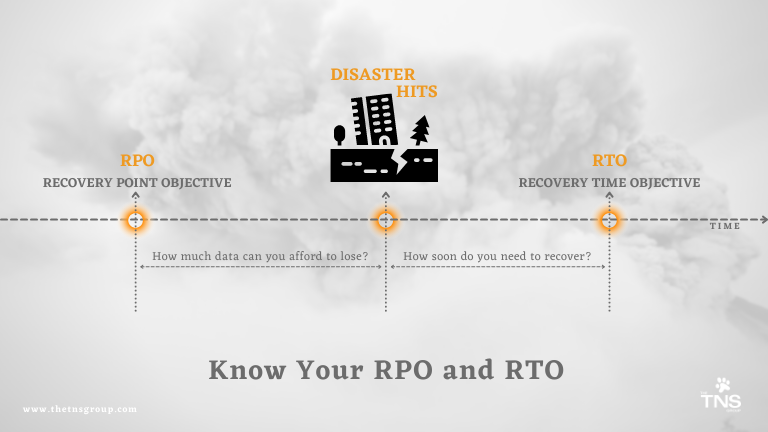
Take a deep breath and think about your daily operations and everything that goes into defining who and what you are as a business. Your infrastructure. The people you serve and those who serve with you. Years of data. Your products or services. All the fruits of your labor (so to speak).
Now, envision how you would recover from a complete loss or drastic business interruption. Does the image you see give you peace of mind, or does it spark feelings of anxiety and fear? If your answer is the latter, you’ll benefit from reading the rest of this blog and maybe add it to the list of things you can be thankful for this Thanksgiving.
What is a Disaster Recovery Plan?
A Disaster Recovery Plan, or simply DRP, is a major subset of your Business Continuity Plan or BCP. Disaster Recovery (DR) is not about getting things back to ‘normal.’ ‘Normal’ includes several non-critical systems that can wait. DR is about getting the minimum required system functionality for your business to continue to operate in the event of a disaster. Essentially, your entire organization should have backup resources that can be activated at a moment’s notice to give your business a fighting chance in a crisis.
In today’s highly crowded and competitive environment, it is becoming more and more difficult to build a strong corporate image. It’s even more difficult to regain it should your image get tarnished due to downtime. People need speed. Consumers expect organizations to respond quickly, or they’re often too willing (and hasty) to go elsewhere. Every minute of service disruption costs businesses thousands of dollars in lost customers, sales, and revenue.
Although no one can guarantee 100% continuity in the event of a crisis due to the uncertain nature of situations, bringing together effective collaboration with ample planning and preparedness can save your organization. Whether you’re creating one from scratch or improving an existing plan, our advice is to factor in the following considerations.
Elements of a Good Data Disaster Recovery Plan
- Analyze all potential threats and possible reactions to them.
Malware and ransomware. Natural disasters. System failure. Cybercriminals and rogue employees. It’s impossible to cover every single risk a business could potentially encounter. So as best you can, try to anticipate which potential disruptors are most probable. For instance, your business probably doesn’t have to worry about a tornado, but there’s always a chance that your office could suffer a power outage or a cyberattack.
You should then spell out a recovery plan for each scenario. Know what needs to be recovered first, where all your priority information is, and how to get to it. For many businesses, this will be customer-facing data—websites, client login portals, and any information that needs to be accessed by your customers. It should also include your most sensitive business information.
- Keep your DRP documentation concise.
A 100-page (or longer) DRP manual can be far too overwhelming to maintain and can end up useless in an actual crisis. You and your team will benefit more from concise DR documentation that is stripped of excessive content and is written for the people who would be executing the recovery. Use flowcharts, checklists, and diagrams. Since 65% of people are visual learners according to the Social Science Research Network, the best way to drive the message home is through visual content.
- Define your RPO and RTO.
It is essential to evaluate your resources and define which of them are driving your business, generating revenue, and keeping your operations going. There is no one-size-fits-all recovery solution.
Establishing your Recovery Point Objective (RPO) and Recovery Time Objective (RTO) requires input from various departments to best assess your business needs. Before a disaster hits, determine how much data you can stand to lose, your RPO, as well as how quickly things need to be restored, your RTO. This diagram illustrates these two objectives clearly.

Map out your RPOs and RTOs concurrently to compare downtime costs with the impact on your business, looking at the variables of lost revenues, wages, and recovery expenses.
- Designate a recovery team.
After identifying your business’s prime vulnerabilities, designate a team that will be directly involved in recovery efforts. Identify by roles and responsibilities the critical people charged with responding to a crisis and list their full contact information. This team of key players should have the ability to steadily make choices that reflect the best outcome for your business. Be realistic about your expectations and ensure that you are a top (or tough) leader throughout the recovery process.
- Create a communications plan.
Ensure that roles and responsibilities during an incident are clearly defined and well-established. It’s also important to have a crisis communication platform that everyone can access. Consider the following guidelines:
- How will you keep in touch with partners and shareholders?
- How will employees communicate during the incident?
- How will you notify customers of the incident?
- Train your team and practice.
Implementing a DRP is great, but it has no meaning if you don’t know that it works! If your team doesn’t know what they are supposed to be doing, the plan is ineffective. Practice disaster drills to make sure everyone knows what to do when a crisis occurs. Not only does practice allow your team to get comfortable, but it’s also an opportunity to learn from potential mistakes, allowing you to improve with every disaster drill.
- Review and revise regularly.
If you leave your DRP untested until your first disaster, it’s likely you’re going to find weaknesses at the worst possible time. Have a plan to change the plan. For one, technology continues to evolve to meet the changing times. Your plan isn’t complete unless it considers all the technologies, systems, and applications currently in use.
- Partner with an expert.
Tied up with sales, day-to-day operations, and innumerable priorities, entrepreneurs like you can find Disaster Recovery Planning incredibly overwhelming. In fact, six out of ten SMBs even consider DRP a luxury. The truth is, however, DRP is a business requirement—every organization needs one if they are to stay relevant in today’s competitive market.
Fortunately, moving data operations into the cloud has made DR easier and more economical, enabling more and more organizations to be better prepared for disasters. At TNS, we understand that your focus should be on staying in business, not worrying about backup or access to your applications, when a disaster hits.
With local backups, replications to the cloud, and failover sites, our TNS Protect solution ensures that your business and assets are safe and accessible when you need them the most. We work collaboratively with our clients to develop an effective Disaster Recovery and Business Continuity Plan which will incorporate a strategy and a solution. Contact The TNS Group today to get started with your Disaster Recovery Planning for 2022.
Categories: Managed Service Provider, MSP Blogs, Solution Blogs




